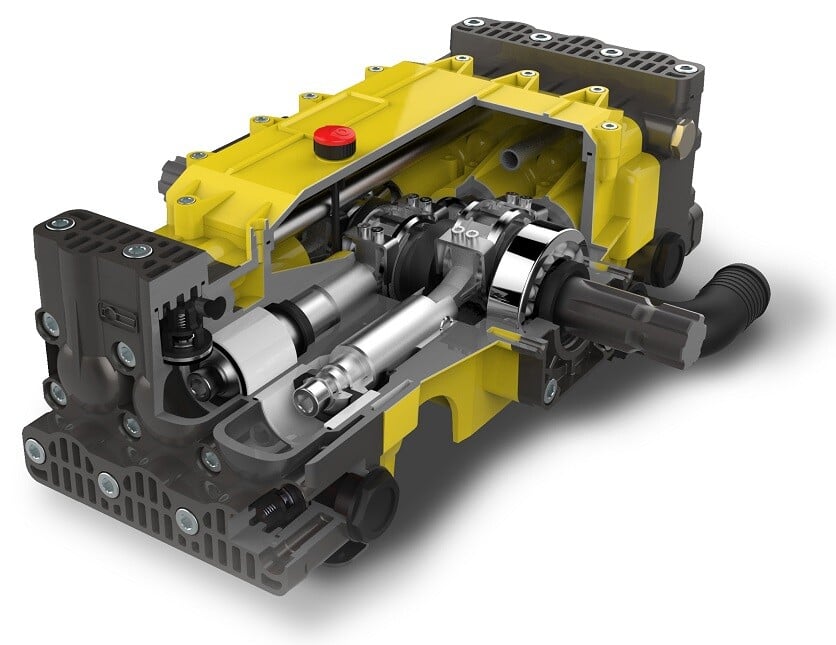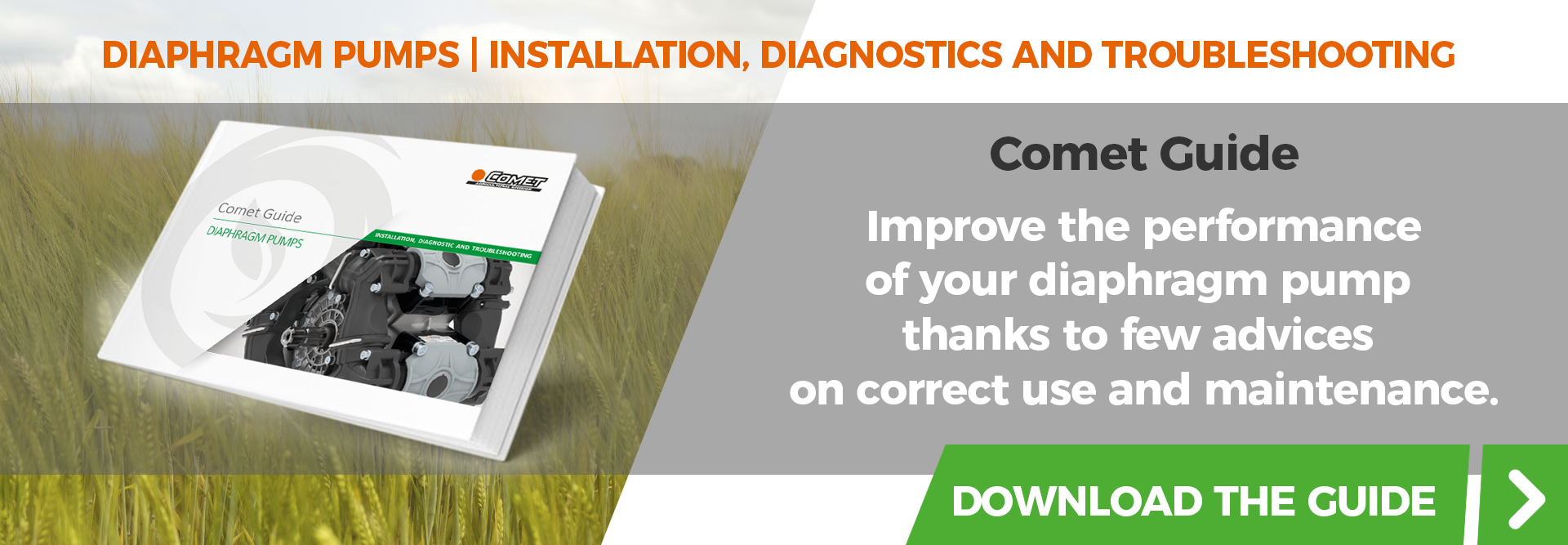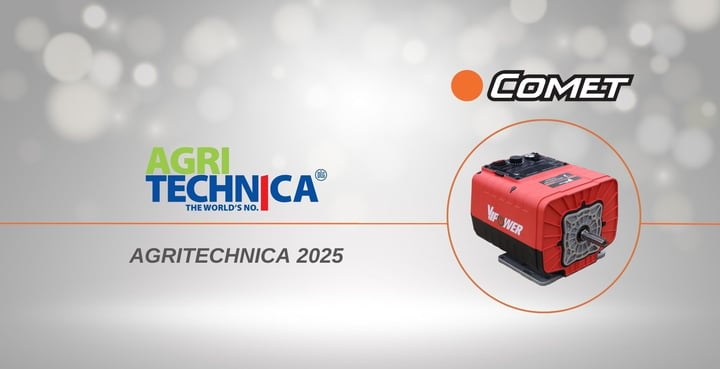Air blast spraying, spraying, irrigation: there are many applications in agriculture that involve pumps, and just as many types of pumps exist and are used.
Air blast spraying, spraying, irrigation: there are many applications in agriculture that involve pumps, and just as many types of pumps exist and are used.
In this article, therefore, we will look at the main types of pumps used in agriculture and reveal the advantages and ideal applications for each.
The main types of pumps
Pumps used in agriculture can be grouped into three main types:
- Diaphragm pumps
- Piston pumps
- Centrifugal pumps
They are different types of pumps with different characteristics, either structural or functional, each of which more suitable for one or more specific works in the fields or different crops. What they all have in common, however, is the main function for which they are used: pumping liquids.
We have already talked extensively on this blog about diaphragm pumps as one of the flagship products in Comet’s agricultural range.
READ ALSO: DIAPHRAGM PUMPS, WHAT THEY ARE AND HOW THEY WORK
In this article, however, we will “go beyond” by also analyzing the “competitors” of the diaphragm pumps - the centrifugal pumps and piston pumps - to understand how they are composed and how they work, comparing them with each other to understand what special applications of agricultural work are best suited for each type of pump.
.jpg?width=539&height=578&name=pompa%20membrana_IDS-1701_(spaccato).jpg)
How diaphragm pumps work
Diaphragm pumps belong to the category of positive displacement pumps: that is, they exploit the alternation between expansion and contraction of a chamber to generate pressure imbalances between the chamber and the spaces contiguous thereto. These changes in chamber volume are generated by the alternating oscillations of an elastic diaphragm.
This pressure imbalance gives rise to the pumping of liquid, mainly those used for air blast spraying and spraying of products useful for pest treatments and weed control in crops.
The advantages of the diaphragm pumps
As there are so many and varied of them, we will limit ourselves to listing only the 3 main advantages which can be obtained by using a diaphragm pump in agricultural work.
First, their excellent priming and self-priming resulting from the ability to create good vacuum on the intake line. In this way, diaphragm pumps can effectively lift fluids from levels below where they are, such as from channels, basins or tanks.
Secondly, their good ability to run dry without suffering (as happens, for example, to centrifugal pumps) damage from overheating or seizing. This is achieved by a lubricated drive mechanism and its own ability to create good vacuum on the intake line.
Finally, the element that most distinguishes these pumps. Manufactured from special materials that are compatible with and resistant to the most aggressive chemicals, these diaphragms also separate the oil-bath mechanical part of the pump from the pumped liquid, making them the only ones that can pump liquids that are not perfectly filtered or mixed with acids and solvents.
READ ALSO: 3 MAJOR ADVANTAGES OF USING A DIAPHRAGM PUMP AS AN AGRICULTURAL PUMP

How piston pumps work
Like diaphragm pumps, piston pumps also belong to the group of positive displacement pumps and are distinguished by the alternating movement of the pistons themselves.
Such a pump, specifically, consists of a cylinder with two chambers, one inlet and one outlet: inside the cylinder runs a piston which, with its repeated movement, pushes the fluid into one chamber of the cylinder while simultaneously pushing the liquid out of the other, thus creating in both chambers the pressure needed for pumping.

The advantages of the piston pumps
There are countless areas of use for piston pumps, from construction, to the food and pharmaceutical fields, to home and professional cleaning; in agriculture, however, they are particularly suited for so-called fertigation.
Thanks to their high precision, they prove essential for injecting fertilizers and chemicals in a controlled and effective manner. Piston metering pumps, for example, are used to inject and measure precise amounts of liquid fertilizers into the irrigation system.
The structural composition also gives piston pumps several advantages. Sealed chamber and special materials for water seals, for example, give reliability and long life even under stressful working conditions. Dual flow pistons, on the other hand, allow two products to be pumped at different flow rates by using only one pump.
By comparing the diaphragm pump with the piston pump, it can be said, generally speaking, that the former is more suitable for treating abrasive or low-viscous liquids, while the piston pump is more efficient in treating viscous liquids in high-pressure systems.
How centrifugal pumps work
The last type to be analyzed is the centrifugal pump, a dynamic pump that uses the force of an impeller to turn mechanical energy into hydraulic energy. This conversion is produced by the impact the fluid undergoes as it passes through the impeller, accelerated by the centrifugal force, then flowing radially outward and out a diffuser. The speed to which the fluid is subjected substantially produces kinetic energy that is converted into pressure energy.
Like piston pumps, centrifugal pumps are particularly used in agriculture for irrigation, but they are generally the optimal choice when the fluid to be treated has viscosity characteristics similar to water or if it contains no solids or air.
Depending on the type of impeller, various types of centrifugal pumps can be distinguished, ranging from the open impeller pump, suitable for liquids with higher concentration of impurities, to the closed impeller pump, suitable for clean liquids or those with a slight presence of suspended solids, to the semi-open impeller pump, and so on.
All usually dipped in water, centrifugal pumps can be further classified as follows:
- Submersible pumps: dipped in wells, lakes or ponds, they do not require priming and are very useful when the available water level is low.
- Turbine pumps: very similar to the previous ones, they can be installed either on land or in water but have lower efficiency than submersible pumps
- End suction pumps: widely used for small and medium-sized irrigation, such as watering gardens, lawns or small fields, as they can handle different pressures and flow rates.
- Jet pumps: also called surface pumps or water lifters, are used to pump water from wells or other sources where the level is too low to run other pumps. The feature that makes them unique is the ability to create a high-speed water jet that creates a partial vacuum so that water is sucked through a tube.
Advantages of the centrifugal pumps
One of the main advantages of the centrifugal pumps is that they are less prone to leakage. In addition, they can handle hazardous liquids and have lower friction loss than other pumps. In contrast, the flow rate of centrifugal pumps varies with pressure: if centrifugal pumps need to be constantly primed in the liquid, diaphragm pumps may run dry because of their ability to suck in the air contained in the suction pipe during startup and to remove it through the delivery line (self-priming).
The fact remains that centrifugal pumps are among the most widely used because of their moderate price and good value for high-flow applications.













